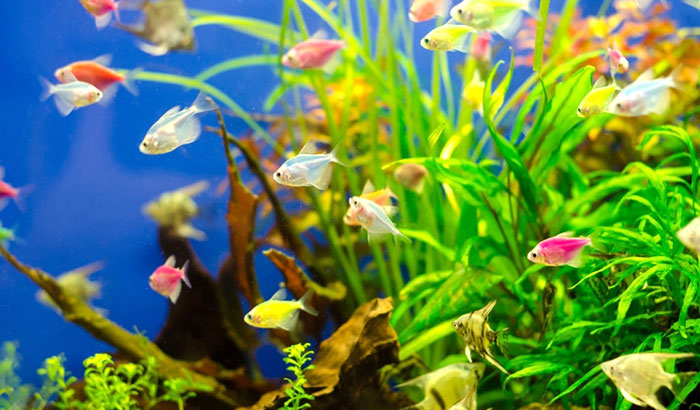Glofish are genetically modified to become more colorful and emit a fluorescent glow. They are excellent options for a more vibrant and amazing-looking aquarium. But do you know how to take care of Glofish? This post will give you the basics of taking care of these engineered fish. We will tackle topics such as their diet, feeding frequency, population control, water conditions, breeding, aquarium elements, and more. Let’s begin!
Contents
The Glofish Diet
What do Glofish eat? Glofish are not very picky eaters. As long as you provide them with a wide variety of fish food products, these fish will survive. Since they are omnivorous, Glofish will eat flakes, pellets, frozen or freeze-dried fish food. They also appreciate live foods like bloodworms and brine shrimp.
And to be safe, you can supplement a special Glofish flake that will enhance their colors. These flakes are not a complete diet in and of themselves, though. The flakes should only be a part of a balanced diet.
If you want to get deeper into the Glofish diet, look for foods rich in carotenoids and beta carotene. These nutrients will help the fish retain their vibrancy and luminescence.
Since we’re talking about their diet anyway, we should also discuss how often do you feed Glofish. The official Glofish website suggests feeding the fish once or twice a day on average.
Population Control
In an aquarium, it is vital to think about the fish population and whether they are comfortable. As a baseline, let’s discuss how many Glofish in a 10-gallon tank is appropriate. Most Glofish are very small, but one of the tiniest kinds is the Glofish Tetra, the maximum size of which is two and a half inches.
At the most, five of these Glofish will live comfortably in a 10-gallon tank. To avoid getting lonely, you should put at least five of the same species in a single tank. So, if you only have a 10-gallon tank, you can only afford to get one species. If you have a 20-gallon tank, you can probably get five each of two separate species.
Sufficient space is essential to fish care. If the Glofish don’t get enough space to swim about freely, they might get aggressive, and that’s bad news for you.
What Other Fish Can Live with Glofish?
Do you have a large enough tank to accommodate five of a Glofish breed plus more fish of different species? If so, you need to know what other fish can live with Glofish. Small fish species are the best options for a Glofish companion. These breeds include tetras, angelfish, barbs, danios, and other freshwater fishes not big enough to eat or harass them.
Water Conditions
In this section, we will discuss the best environmental conditions for Glofish. We will look at the suitable range of water temperature, acidity, and more.
Temperature
What temperature do Glofish need to thrive? The temperature range in which a Glofish can thrive is from 72 to 82°F (around 22.22 to 27.78°C).
Filtration
Do Glofish need a filter to survive? Although they are genetically engineered, Glofish are just like any other aquarium fish. They need filtration to eliminate nitrites, ammonia, and other toxic contaminants from their tank, or they will suffer serious health problems – at worst, even death. Without proper filtration, the Glofish may lose its vibrant color slowly and die.
Lighting
Do Glofish need light at night despite being bioluminescent? No, Glofish do not need light at night. And that fact has nothing to do with their bioluminescence.
Glofish are freshwater fishes. And just like most tropical freshwater fish, they need twelve hours of light and another twelve hours of darkness each day. Keeping them in the dark at night is actually ideal for their health and survival. Plus, keeping them in the dark at night lets you enjoy their majestic and luminescent beauty.
Breeding
Glofish are not a separate class of species; they are genetically engineered from other species. Glofish species are as typical as bettas, danios, or barbs. If you want to breed Glofish, you have to know the breeding behavior of their species.
For example, if you have a danios Glofish, you should keep them in groups because danios like to breed in spawns. They will not pair up; instead, a female will deposit eggs, and the male will fertilize them afterward.
In contrast, betta Glofish breed differently. The male will build a bubble nest on the water’s surface and attract a mate to it. Once paired, the male and female will participate in a courtship and mating ritual. The female will then lay eggs, and the male will retrieve them and place them into the nest.
In short, each Glofish species breeds differently. You should know how the specific breed reproduces.
The same principle applies in knowing if a Glofish is pregnant. If you want to learn how to tell if a Glofish is pregnant, you should be familiar with its species.
Let’s take the danio again as an example. Because danios are not livebearers, they don’t get pregnant. The closest they get to pregnancy is when the female carries roe or eggs. You can tell that the female is ready to reproduce when she becomes wider than usual.
Conclusion
I just gave you the basics of how to take care of Glofish. If you’re asking yourself, “Why did my Glofish die?” you probably made mistakes in their diet, population control, and water conditions. Glofish, like all aquarium fishes, need enough space in a tank, the right temperature, filter, and lighting conditions. If you don’t meet these needs, you will not enjoy the beauty of these vibrant fishes.

